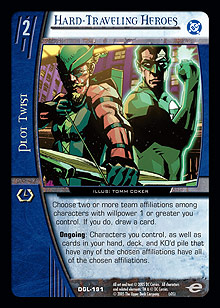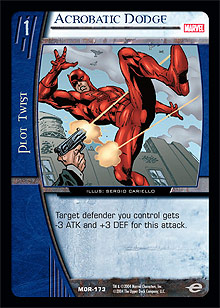
For the average Vs. player, getting all of the cards needed to play a competitive Constructed deck is like digging for buried treasure. Let’s face it . . . how many packs do you have to open before you get four Savage Beatdowns? And let’s not even talk about prices in the secondary card market. But you needn’t open hundreds of packs or shell out hundreds of dollars just to get a good deck. All you need is three booster packs for each player, and voila! You’ve got enough cards for a Draft.
Playing Draft is a great alternative to both Constructed and other Sealed Pack formats. First of all, Draft takes more skill than Sealed Pack because you’re basically working from the same pool of cards as your opponents; it’s up to you to pick the best cards for your deck while at the same time trying to deny your opponents the best cards. It’s also more fun and takes more skill to draft a deck than to pull the latest Constructed decklist off the Internet.
But like many players, I at first felt intimidated by drafting. I mean, what if I passed up a really good card? It’s easy to become demoralized when the player next to you shouts out, “I can’t believe you didn’t take Sabretooth, Feral Rage!” But you needn’t feel insecure about drafting if you follow a few basic guidelines.
 Choose Your Teams Early
Choose Your Teams Early
Ideally, you want to narrow your character picks to two teams with maybe a sprinkling of a third team. That way, your characters can more easily reinforce each other, thus limiting breakthrough endurance, and they can team up their attacks to take down beefy characters. Keep in mind, though, that Green Lantern introduced a lot of team-up cards, like Millennium and Hard-Traveling Heroes, that make it easier to get away with playing multiple teams. If you have two or three team-up cards in your deck, it’s probably safe to play three teams.
By the time the first booster pack has been drafted, you should have a pretty good idea of at least one of the teams you’re playing (though you don’t want to make the mistake of automatically playing the team of the first character you draft). If you don’t know at least one of your teams by the end of the first pack, you’d better decide early in the second pack, or else you might end up with a mishmash of characters or with plot twists and locations that don’t support your characters. By the end of the second pack, you should know your other team, as well. Once you know what teams you’re playing, you can concentrate on picking characters, plot twists, and locations that supplement those teams.
Make Sure You Have a Good Character Curve
There’s nothing like the “I’m screwed” feeling of missing an important drop. I’m not talking about missing a 1-, 2-, or even a 3-drop. But on turn 5, when your opponent plops down a 5-drop Daredevil, Matt Murdock and you can only a play a 3-drop Brother Voodoo, you can bet you’re in for a beating. And the beating turns into a beatdown if you miss higher drops.
To minimize that from happening, you need to draft the right number of cards for each drop. You don’t want to draft too many 1- and 2-drops because you don’t want to be stuck with a handful of wimpy characters on later turns. And since you’re drawing two cards every turn, it’s not necessary to have a bunch of big characters, either. After all, by the time turn 7 rolls around, you’ll have drawn more than half the cards in your deck. Your arsenal of characters should resemble the classic bell curve—you should have zero, one, or (at most) two 1-drops; one or two 2-drops; two or three 3-drops; four or five 4-drops; four or five 5-drops; three or four 6-drops; one or two 7-drops; and maybe a single 8-drop. You should have about twenty characters in all, and the remaining cards in your thirty-card deck should be plot twists, locations, and perhaps a highly useful piece of equipment.
Keeping track of what cards you’ve already drafted can be challenging, though. If you’re playing by tournament rules rather than “friends getting together to play” rules, you’re only allowed to look at your cards after an entire pack has been drafted (and before the next pack is opened). Take advantage of this time to examine your cards, but also try to keep a mental tally of how many characters you’ve drafted for each drop and the number of good plot twists you’ve managed to snag. That way, when you’re down to the last pack, you can choose cards that will compensate for your weak spots.
Choose the Best Cards
It sounds like a no-brainer, but it’s not always easy to see that one card is superior to another. When you’re drafting, cards that are useful in any deck are solid picks, first of all because you know you can use them, and secondly because you know your opponents can use them too. Team-up cards and plot twists and locations that pump ATK or DEF tend to be superior picks, especially early in the drafting process. Once you’ve chosen your teams, the best cards for you will be those cards that fill in character holes or weak spots in your deck. Depending on whether the set you’re playing has a lot of high-drop cards, 7-drop characters might be good early picks as well because those without loyalty can be sprinkled into any deck, regardless of team affiliation.
 Keep in mind that defensive plot twists are usually better than offensive ones. There’s nothing like the triumphant feeling of flipping over an Acrobatic Dodge as your opponent realizes that his or her attack with Dr. Doom, Victor Von Doom has just been wasted. Cards that pump up a defender’s ATK are good too because you might be able to stun your opponent’s attacker when he or she least expects it, perhaps even ruining your opponent’s whole plan of attack and certainly weakening his or her defense if you get to follow up the attack with one of your own.
Keep in mind that defensive plot twists are usually better than offensive ones. There’s nothing like the triumphant feeling of flipping over an Acrobatic Dodge as your opponent realizes that his or her attack with Dr. Doom, Victor Von Doom has just been wasted. Cards that pump up a defender’s ATK are good too because you might be able to stun your opponent’s attacker when he or she least expects it, perhaps even ruining your opponent’s whole plan of attack and certainly weakening his or her defense if you get to follow up the attack with one of your own.
Draft defensively, but not at the expense of your own deck. Let’s say you’re passed Ultraman and Krona. You suspect that the player you’re passing to is drafting Emerald Enemies, so you don’t want him to get the Krona. But then again, you’re playing the Anti-Matter team, and you really need a 7-drop to round out your deck. It’s likely that you won’t see another 7-drop, so you’d better take it while you can. On the other hand, if there’s nothing special in the pack for your own deck, you’re probably better off defensively drafting the Krona.
And don’t make the newbie mistake of rare drafting. Just because a card is rare, that doesn’t mean it’s better. In most if not all of the Vs. sets, the common cards are highly playable, and some of the strongest cards are commons. If, however, you come across a worthy card that happens to be uncommon or rare, you may be better off taking it over a formidable common card because the common card is more likely to pop up again.
Know How the Cards are Distributed
It’s helpful to know if you can anticipate there being a 6- or 7-drop creature in every pack and whether or not every pack will have a range of plot twists. Back in Marvel Origins, not every pack had a big character (many of the higher-drop characters were uncommon or rare), so it was generally better to snap up bulky characters over plot twists. But in some of the more recent expansions, plot twists and big and small characters are pretty evenly distributed. If you’re new to a set, it’s hard to know how the cards are distributed, but you should have an idea after seeing a few packs.
Even Superheroes Need Practice
Of course the more you draft and play a particular expansion, the better you’ll do. You’ll learn which team combinations are the strongest in a particular environment. You’ll learn which cards are a must to first pick. And you’ll gain confidence. So when the guy next to you yells, “I can’t believe you passed up a Sabretooth, Feral Rage!” you can discount him with a snub comment of your own . . . or you might consider doing an Alley-Oop! when you knock him down to 0 endurance.